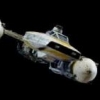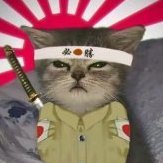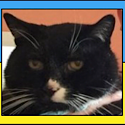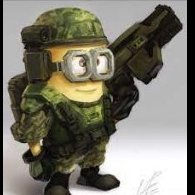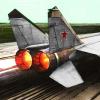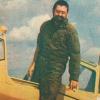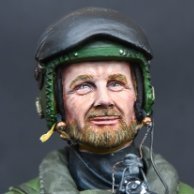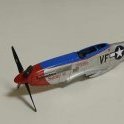Search the Community
Showing results for tags 'Leopard'.
-
Got another older build here, hah. Sadly this one ended up accumulating a bit of shelf dust before the pictures, and as usual I couldn't get it all removed (stuff always sticks). Ukrainian 2A6 in 1/35 scale. My second Tamiya Leopard after the original 2A6 release from the early 2000s (which didn't turn out so well at the time for some reason). Luckily, I've gotten much better 😅 Enjoy Thank you as always for looking Gaz
- 15 replies
-
- 35
-

-

-

-

-
Well it's finished. I've kept it new and shiny looking, well because they are mostly I think? I'd almost forgotten all this was in here - seems a long time ago! Thanks for looking! Nick
- 17 replies
-
- 41
-

-

-
Hello everyone, this is a Leopard 2a7 model from Meng, painted with tamiya paints, varnish from mr color, also used icm and ak paints for some parts. Don't ask why such a strange camouflage, the customer asked for exactly this one, based on the Danish camouflage but with the identification marks of the Bundeswehr. About the model, it has good detailing and sharp details, the only problem i want to highlight is the tracks, they are not difficult but they take a lot of time. In general, I am satisfied with the result. Also the photos should be better because i replaced my old samsung a31 with a new pixel 7
-
I bought this a little while ago and messed up the turret by melting it with acetone to clean the paint off, oh dear. So destroyed Leopard it is then, many many planned shell holes, explosions points, fires, internal explosions, bullet holes and marks, melting and target range mayhem. I have added some additional armour to the front that I've seen in some photos and will need to get the melted turret into some form of presentable as it's absolutely mangled by melting, that and having to mantle my pristine hull and scratch built chequer amour to the front top plate.
-
With the recent uptake in interest in armour related GB's and STGB's I have been having a think about having one for a topic which I have liked for a long time, namely the Leopard family of AFV's. This family of tanks has been at the top of the AFV game since their entry into service in the late 60's and the newest models are still up there. I would have all versions of the Leopard as eligible for GB, including all of the gun tanks from the Leopard 1 onwards and all of the other vehicles which have used the hull of the Leopard in one form or another such as the Gepard anti-aircraft tank and the Biber armoured bridgelayer. There are plenty of operators from Australia to Chile so there is a good range of colour schemes and markings that your model can be finished in, and as such no whiff's I'm afraid. If you want a build a version that didn't get into service but was made as a prototype then that will be fine, it was built after all. There are plenty of good kits out there in both 1/72 and 1/35 scale, I don't think there has been a 1/48 kit yet, and a range of aftermarket goodies and decals available too. So what do you say, fancy doing something a bit more modern than Panthers, Tigers and Shermans? 1; Me (obviously) Host 2; Plastix co-host 3; Corsairfoxfouruncle 4; klr 5; desert falcon 6; Julien 7; helios16v 8; HobbyPaul 9; diases 10; Arniec 11; Mig Eater 12; fatfingers 13; ijs302; 14; trickyrich 15; badger 16; Foxbat 17; Orso 18; Flying sailors 19; Rocky 20; KRK4m 21; Zack 22; TonyW 23; Rob S 24; Dermo245 25; GREG DESTEC 26; Airfixpeter 27; Bertie Psmith 28; Sardaukar 29; RedDot 30; Covjets13 31; spruecutter 32; TonyW 33; MarkSH 34; Steben 35; Marklo 36; Silenoz 37; PeterB 38; Softscience 39; Vppelt68 40; ColonelKrypton 41; Cammer62 42; Nickhenfrey 43; Sardaukar 44; JTninja 45; Mippie
-
The Kit Still haven’t decided which scheme but one of the above. Some small modifications required, most notably the skirts and possibly the mantlet. The obligatory sprue shot This should be a quick build with he bulk of the construction completed by the weekend.
-
Bergepanzer BPz3 Buffalo ARV (84565) 1:35 Hobby Boss via Creative Models Ltd # The Büffel as it is known as in its native Germany, is an Armoured Recovery Vehicle based upon the chassis and lower hull of the well-liked Leopard 2E Main Battle Tank, which itself is a variant of the 2A6. Most of the hull is identical or similar to its progenitor, but the turret is missing, replaced by a crane, a winch and a bulldozer blade that allows it to retrieve damaged or immobilised tanks from the battlefield even if the fighting is still ongoing thanks to its armour. It is also equipped with an MG3 machine gun for self-defence purposes, a set of smoke grenade launchers to hide itself and its charge from those that wish it harm. It is powered by a large 12-cylinder diesel engine from MTU Friedrichshafen, a division of Rolls-Royce, that outputs almost 1,500bhp that allows it to travel at good speed across all sorts of terrain, but also to pull its immobilised compatriots, whether they were retrieving Leopards or PzH2000 SPGs, or anything up to a similar tonnage. The BPz3 was a joint project between Rheinmetall Landsysteme of Germany who produced an initial 75 for the Bundeswehr and a further 25 for the Netherlands, where its name lost its umlaut over the U in translation. It was also sold to other countries including Canada where it is known as the L2-ARV, and Spain where it is known as the Leopard 2ER Búfalo, with Switzerland a surprisingly large 25 export, and Sweden taking a number on charge after adapting them to their specific needs to improve armour and customise their electronic systems. For service in Afghanistan, the German vehicles and some Canadian machines were upgraded with new high quality vision systems by Karl Zeiss for the drivers that would give them 24/7 visibility, no matter what the conditions. The crane is electrically driven, and can operate independent of the power-pack, so even the unusual sight of a Buffalo replacing its own broken engine isn’t outside the bounds of possibility, presuming they have enough electrical charge in the vehicle. At time of writing, the type is in the middle of another extensive upgrade programme to give it more capability on the interconnected battlefield. The Kit This is a partial retool of the 2015 release from Hobby Boss, adding a substantial number of new parts to depict the differences between the Buffalo and the original Canadian variant that was tooled. The kit arrives in a typically sturdy top-opening box with a painting of a Buffalo at work on another tank, and inside are twelve sprues and two hull halves in sand-coloured styrene, a small sprue in black, a clear sprue, two trees of poly-caps, a length of braided wire, two Photo-Etch (PE) sheets of parts, two flexible black lengths of track, the decal sheet and the black and white instruction booklet that has the colour painting guide between the centre pages. Detail is good throughout, as we’ve come to expect from Hobby Boss’s armour models for the most part, although there is some thought that the hull is around 4mm narrower than it should be, but that’s a question for your micrometre, not mine. Construction begins with the lower hull, which has the suspension and return roller details added while the road wheels are prepared, consisting of fourteen pairs of main wheels, two drive sprockets and two idler wheels, all of which have a poly-cap sandwiched between the two halves. Once the swingarms with stub-axles are glued in place, the road wheels can be pushed into place for removal during painting if required, thanks to the temporary nature of the flexible polythene sleeves. Quickly, the bulldoze blade is built from large, bulky parts, adding the supports and pivots, plus a large towing eye at the front of the blade. It is joined to the hull by a pair of large pins that you can leave unglued if you wish to move it later. The track runs are of the “rubber-band” style, but have good detail throughout, and you are advised that they will accept standard plastic glue and paints during creation. There is an overlap of two links on each run, and once the glue is dry they are slipped over the running gear so that attention can turn to the partial interior that is included. The interior is begun by taking a floor panel with upstands around much of the sides, and detailing it with three crew stations and their copious equipment and comfortable seats. The completed lower half (there is more to come) is glued into the bottom of the hull along with an insert against the lower glacis plate, and at the same time the rear bulkhead with towing eyes and shackles are put in place along with the convoy-light shield that has a PE bracket over it. The “more to come” begins with the upper hull half, which first receives an insert over the front that has two holes in it, and creates the roof of the casemate in which the crew sit. A very detailed insert is made up into a four-sided assembly into which a lot of equipment is placed over the space of five steps, including tools and even some decals. That is glued into the casemate and backed up with a box and some brackets, then more equipment and wall panels are dotted around the left side of the casemate after being detailed in rather busy steps around the main diagrams. Similarly, the right side is built around a long insert with five steps that increase the level of detail exponentially, and includes PE and styrene parts as well as some decals for stencils and dials. The driver’s console with lazy D-shaped steering wheel is inserted into the glacis plate, then the assembly is turned over to detail the exterior, including some spare track links from the black sprue, and additional towing eyes that are mounted on the back of the casemate. Ice cleats are placed on the flatter areas of the deck in groups, light clusters, grenade launcher packs, hooks and a pair of coils in braces, as well as all manner of small parts are all dotted around the upper hull, in diagrams that are again somewhat chaotic, so it might be an idea to cross them out once you’ve completed each little section. The numerous hatches around the casemate are prepared with handles on both sides, and can be left open if you wish to show the insides, and one has a large retraction mechanism embedded in the open door. The driver’s hatch is given clear vision blocks before it is inserted into the hole, and at the rear the bulkhead with hanging mudflaps, and short mudflaps at the front bracket the hull. The two hull halves are joined together, and more detail is used to clutter up the engine deck with its moulded-in cooling fan grilles that includes pioneer tools and other equipment that would be useful. The side skirts on the left side are moulded as a main run with a separate rear part around the drive sprocket area that are repeated in mirror-image on the right, and back on the engine deck a substantial frame is built up from a substantial number of parts, including some fine PE brackets, attaching to two blocks on the middle of the deck and raised slots on the rear of the casemate. Additional towing bars and equipment boxes are festooned on the diminishing free space on the engine deck, with another raised platform that contains spare wheels and other tools/parts, additional rear-facing grenade launchers, and two large honeycomb platforms that sit over the twin cooling vents, with enough room to allow them to do their job. The remaining hatch is for the commander/gunner, and has a ring of six vision blocks, central laminated hatch, periscope and a remote variant of the MG3 machine gun on a crane-like mount, with the finished assembly dropped into the hole in the top if the casemate. Much bracketry is fitted around the rear bulkhead, and a short arm is locked in place on the right side of the deck, then the main crane is started. Built around a single three-sided jib, the hydraulic lift cylinder is mounted at one end within the three sides, then closed over by the forth side, with a V-shaped cut-out to allow the movement of it and its ram, which is attached to a two-part topper with the turntable beneath it, mating by inserting the ram into the cylinder and positioning the pivot-points at the bottom of the jib with those on the base so that pins can be inserted without glue. Even the crane doesn’t escape the application of tools, with several items on both sides, plus more details and of course the block and tackle that performs the heavy lifting. The pulleys are assembled with brass wire linking them, so some care will be needed, gluing the outer parts and the lifting hook in position, then locating the top pulley into the end of the jib, securing it with a pin from each side, again without glue. Another two towing rods are built with eyes glued to the ends and located on the rear bulkhead by a pair of clamps, rear view mirror, and towing cable that is cut from the brass wire to a length of 115mm and tipped with styrene towing eyes and draped across the engine deck. Markings There are two options available from the sheet, both wearing the same three-tone green/black/brown NATO camouflage. There are instructions to decal the two jibs, the decals for the main jib being on the instruction booklet, while the smaller one on the engine deck is in colour on the main sheet. From the sheet you can build one of the following: As usual with Hobby Boss, there’s no description or era of the subject matter, so a bit of Googling will be in order if you’d like to know a little more about your model. The decals are well-printed, in good register and sharpness, and are suitable to the task in hand. The instrument decals for the interior equipment with dials has a grey background, although much of the interior is painted white or NATO green. Again, Google is your friend. Conclusion It’s a well-detailed model of a niche, but extremely important vehicle in the Bundeswehr and other operators, with a lot of attention that has been paid to the interior, as well as the exterior. You don’t get the engine, but that’s not a big deal. Highly recommended. They’re out of stock presently at Creative, but check back soon as it has been a popular subject. Review sample courtesy of
-
Leopard C2 MEXAS With TWMP (Track Width Mine Plough) 1/35 HOBBYBOSS via Creative Models In 1978 the Canadian Army selected the Leopard 1A3 to be its new Main Battle Tank. These would be called the Leopard C1 in service. In 2000 it was decided to upgrade these tanks with the fitment of surplus German Leopard 1A5 turrets. At the same time armour protection was increased, and a new fire control system was added. In 2006 some of these tanks were sent to Afghanistan where they would be fitted with an additional upgrade, the MEXAS system. This stands for Modular Expandable Armour System which was developed n=by IBD Deisenroth Engineering in Germany. This is a new composite armour system which can be added to many vehicles include tanks to increase survivability in these modern conflicts where IEDs and RPGs feature heavily. The Canadians also fit a version to their LAVs. The TWMP unit for Canada was developed by RAMTA a division of Israel Aircraft Industries. The unit clears a path for the width of both tracks (1m) to 200, 250 or 300mm by moving the mines aside. A "dog bone" is dragged over the uncleared 1.5m central lane to detonate any tilt road mines. The unit fits to the front of the tank via an Engineer Equipment Interface Kit developed by Krauss-Maffei. This allows the plough or a dozer blade to be fitted. The Kit This kit from HobbyBoss is a re-boxing of the standard Leopard 1 with different parts for the Canadian Leopard C2, and additional sprues for the TWMP. Its worth noting the kit does not feature the thermal blanket and cooler fitted at a later date by the Canadians in Afghanistan. The kit looks good on the sprues with lots of detail parts. Moulding is first rate. Construction starts lower hull. Various suspension components are fitted, and the ends of the main torsion bar system and its arms are fitted. The wheels can then be built up and attached, followed by the tracks which are individual links. While at first glance thy look good and there is a jig provided in the kit to make short runs of track however it will take some work to get them right; and the end connectors are moulded to the links so will not articulate like the real ones when the runs go round the end sprockets. The next step is a surprising one in that it looks like a full power pack is provided. While the engine has many parts and looks quite detailed there is no detailing for the engine bay, and the actual block is missing all of its hoses and connector, though there is nothing stopping the modeller going to town here if they want to do an open engine bay. Then the rear bulkhead is made up. There is virtually no moulded on parts here with a lot of small detail parts making up this bulkhead. The rear mud flaps are fitted to the bulkhead at this point. The bulkhead can then be fitted. Moving to the top main hull the engine deck hatch is added, along with some side parts and the drivers vision blocks, the rear exhausts are then added along with quite a few detailed parts such as tools , mirrors etc. The lower and upper hulls can now be joined and the rear bulkhead fitted. PE parts for the engine deck are then fitted. The additional MEXAS armour packs are added to the sides of the hull and the front. The rear tow cables are then added. Work now moves to the turret which has good casting detail moulded in. The mounting points for the MEXAS armour are all moulded to the turret. After the turret is together the large rear mounted turret storage bin is made up and added to the turret, Next up the roof mounted machine gun and its mount can be added. The ECM system and MEXAS armour units can then be assembled and added to the turret. Next up the hatches and aerial mounts are added. The gun and its additional armoured mantlet are built up, There are two guns in the kit and the one with the mounting straps for the muzzle referent mirror on it. These are then added to the turret after it is assembled There is a canvas mantlet cover to add, this is a basic representative of the real thing and aftermarket detailed one are available to replace this one, in addition to would seem the Canadian's replaced the original covers with one of their own making. Like a lot of Leopard kits the kit barrel is not entirely accurate due to the complexities of the real thing and the limits of plastic moulding technology. The smoke dischargers are added to the turret and its then ready to be mounted to the hull TWMP There is one main sprue of parts for the Mine Plough and a smaller on for all of the hull fittings and additional parts. The central mount is first built up along with the ground riding skis. The side plough units are then assembled and the three parts joined. A small lenth of chain is provided for the tilt mine system between the loughs. Once assembled the unit can be mounted to the tank. Decals Decals are provided for 1 tank, though there in usual HB style there is no information on these provided at all in the instructions. Conclusion This is a great looking kit from HobbyBoss and their attention to detail is to be commended. Overall Highly recommended. Review sample courtesy of
-
Last years lockdowns caught me(like most) on the hop and i decided to go along a different modelling avenue to my normal F16 route. All the kits came from UK sources, some were new, others 2nd hand. I don't or didn't build large scale armour at all until i started this lot. As soon as i can link to my source , i'll post some pics (Scalemates appears to be offline at this time)
-
Hi all, Anyone fancy having a go at a Leopard? Surely one of the best post war families of AFV's in the World and also in service all around the World from Australia to Chile and in a variety of marks and colour schemes. I have a proposal going in the Group Build Chat section for an STGB on the type; Any vehicle based on the Leopard chassis would be eligible from the Biber to the Gepard and all the others, also any prototype that got as far as being built will be allowed, no paper panzers though as there's more than enough out there to keep us happy. We need to meet the magic number of 25 volunteers, currently we have 11 signed up, so what do you say, fancy having a go at a modern classic? You will be made very welcome, especially if this is your first GB. Craig.
-
Leopard 1A5 1:35 Revell The Leopard project started back in the mid 1950s with the goal of producing a modern tank to replace the M47 and M48 tanks which where then in use by the recently reconstituted Bundesehr (German Army). The specification called for a tank weighing no more than 30 tonnes capable of surviving 20mm rapid fire cannon and having a power-to-weight ratio of 30hp per tonne. The tank had to be capable of surviving on a nuclear/chemical contaminated battlefield. Armament was to be the then standard NATO 105mm gun. For this design Mobility was the primary concern with firepower secondary, and armour being seen as low down the list as it was envisaged there was little possibility of standing up to modern hollow charge weapons. Three design teams competed for the Tank contract from Porsche, Rheinmetall and Borgward. The Porsche prototype was eventually selected as the winner. Production was set up with Krauss-Maffei in Munich and deliveries began in late 1965. In the 1980s research was done into upgrading the tank. The turrets were upgraded to store more ammunition, a new, and a new fire control system was fitted. Provision was made for bolt on Lexan armour, and the 120mm gun of the Leopard 2 (though this was never fitted) As well as the German Army the Leopard 1 would go on to serve with the Armies of Belgium, Holland, Norway, Italy, Denmark, Australia, Canada, and Turkey. The A5 with Germany, Holland and Chilie. The Kit The kit is a welcome addition to the new tool from Revell of an important cold war tank.. The kit arrives on sprues of plastic, one set of rubber band type tracks and a length of aerial wire taped to the instruction booklet (Revell seem to do this for every kit now). Construction starts with the lower hull of the tank. The sides are built up, and an internal bulkhead is added along with the rear of the tank. The next area for construction are the suspension components. 7 top parts are added to each sides along with 7 torsion bar parts. The main road wheels of two parts each, along with the drive sprockets and idler wheels are made up. An additional 7 parts add to the original torsion bar parts at this stage. The single part top idler wheels are also added at this point. The kit instructions have the modeller add the tracks now, these are of the rubber band type with each side being one section. The drivers vision blocks are fitted to the upper hull and then this can be fitted to the lower hull. The track side skirts are then added. The side mounted engine cooling louvres can then be added to the hull along with side lockers and various hull fittings and tools. The rear of the tank then receives some attention. Various fittings, lights, mud guards and tools are added to the back, and the rear engine deck. The front of the top deck then receives the same attention with hull fittings dependant on the nationality of vehicle being built. Construction then moves to the turret. The bottom section is built up with the gun mounting area, the top of the turret is then added. Various fittings are then added to the turret including the mounts for the machine guns. The gun can then be assembled and added to the mantlet, this assembly is then added to the turret. The turret baskets are made up and added, machine guns added to their mounts; and smoke grenade discharges are added. The side armour panels go on. To finish of the turret the mantlet cover is added, the front mounted light is assembled, then added; and lastly grab rails are added. The completed turret can then be added to the hull, the last items to be added are a few parts on the engine deck, the travelling gun mount, and the drivers mirrors are added. Decals Markings are small and in some cases only consist of the vehicle number plates. Markings are provided for four German Army tanks. Decals are produced in Italy and up to the usual stands for these, they are crisp in register and have no colour issues. Conclusion It is good to see a new tool of an important first generation modern Main Battle Tank. Highly recommended. Revell model kits are available from all good toy and model retailers. For further information visit or
-
The kit by Hobby Boss represents an armed version of the tank, although actually the turret with armament was never installed. Building the test version of the vehicle required some scratch-building: the superstructure, the front-plate with windows, covers for the air outlets from the engine compartment, additional air ventilation behind the superstructure and round holders for attaching the towing cable. The mounting of the antenna also had to be removed. The towing cable produced by Eureka XXL (for the Ferdinand SPG). The tracks with separate links turned out to be difficult to assemble, each link required sanding and matching to the neighbouring ones, and the level of their detail left a lot to be desired. In addition, they did not fit the drive wheels. So in the end, I used the rubber tracks from the Sturer Emil Trumpeter kit, for which I bought the ones from Friul anyway. Apart of that, the construction of the model was not difficult and the fit of parts turned out to be very good. Painting with MR Paint paints mixed “judging by eye”, the weathering made with various pigments, mud, and oils from Ammo MIG, AK, and Vallejo. I made subtle chipping with AK graphite. Old school, as they say. Hope you like it :). More photos at my blog. Best, Hubert
-
SLT 50-3 "Elefant" + Leopard 2A4 (03311) 1:72 Revell The huge "Elefant" tank transporter was designed by Faun in the 1970s to meet a requirement for an all-terrain vehicle powerful enough to haul large tanks such as the Leopard. Over 300 have been produced and in the 1990s these massive machines were upgraded to the 50-3 standard represented in this kit. The Leopard 2 was developed in the 1970s as a replacement for the Leopard 1 MBT then in service with the West German Army. Throughout its service life, this highly capable tank has been upgraded through A1, A2, A3, A4, A5 and A6 variants. The A4 included some important changes over the earlier models, such as improved armour, targeting systems and crew protection systems. With over 2,000 on strength at the height of the Cold War, Germany sold off a number of this variant to other NATO countries, making it one of the most successfully exported MBTs of modern times. This isn't the first time that either of these kits have been released by Revell as both have previously been made available as separate kits. Both are original Revell kits and both are relatively modern, although the Leopard is the slightly more recent tooling. The elefant is a significant kit for me as it was the very first kit that I reviewed for Britmodeller, over 10 years ago. Just as it did back then, the kits arrive in the usual end-opening box with the sprues for the two vehicles bagged up separately. The two kits are spread across seven frames of plastic. Thankfully Revell have used a nice, neutral grey plastic instead of the horrid dark green plastic they used in 2010. the parts are all nicely moulded and look just as good now as they did when first released. There is no transparent frame. Instead, Revell supply a thin sheet of clear plastic from which you must cut your own transparencies. The Elefant tractor and trailer occupies the most space in the box and is composed of well over 200 parts. The tractor unit is very detailed, with separate parts for the steering and transmission. The interior is equally well-detailed, with crew seats all moulded individually and details such as the steering wheel all present and correct. Construction should be straightforward, although the plastic sheet transparencies will present something of a challenge. Construction of the trailer unit begins with the chassis before moving on to the suspension and wheels and ending in the loading ramp. The modeller has the option of building the trailer on its own hydraulic feet or attached to the Elefant itself. The loading ramp at the back can also be finished in the fully deployed position for loading or unloading, or folded and raised for transport. The trailer is quite a complex beast, so it should keep the builder occupied for a good while. The Leopard is just as impressive, if not more so. The hull features separate parts for the suspension and running gear and the road wheels are moulded in their inner and outer halves. Needless to say some care will have to be taken during assembly in order to ensure that all the wheels are in contact with the ground before the tracks are fixed in place. Revell took an interesting approach to the tracks supplied with this kit, swapping their usual link and length tracks for thin plastic tracks moulded in two halves. These have to be bent around the wheels and drive sprockets and then glued in place. They are made from the same hard plastic as the rest of the kit and rely on being very thin for their flexibility. The hull and turret follow the usual method of construction and feature plenty of nice details. Pioneer tools are moulded in place but pretty much everything else is moulded separately. Two different options are provides for the Elefant, for vehicles named "Hannibal" and "Kraftwerk". Two options are provided for the Leopards as well, for vehicles belonging to PzBtl 84, Luneburg 4. Kompanie and PzBtl 124, Kummersbruck, 4. Kompanie. All of the vehicles are finished in the usual Nato black/green/brown scheme. The decal sheet is small but nicely printed. Conclusion Revell have produced small scale armour kits of consistent high quality for several decades now. Both of these kits are beautifully made and highly detailed - in fact it's hard to identify how Revell could have improved anything about these models. For fans of modern AFVs this set represents a tempting proposition and should provide many hours of modelling enjoyment. Recommended. Revell model kits are available from all good toy and model retailers. For further information visit or
-
Hello, I have a couple of meng tanks to build, starting with this one. Fairly straight forward build, I like the polycaps. The torsion bar suspension was interesting. I'm really not a fan of the slightly rough finish they put on these models, I suppose it's to help the paint grip. Anyway I'm going to sand it off. I also bought a set of tow cables for it. I'm leaving the side skirts off and painting the underside first, them I'll pop the wheels on, glue on the side skirts, and then paint the rest of it. There isn't much of a glue surface so I want a clean bond so they don't fall off once painted. I'm Starting out with Mr surfacer Black, straight from a can. For a base coat I mix tamiya hull red with flat black about 5050, looks darker than it is in this picture. I bought the Echelon decal sets, I'm quite fond of the Norwegian version, which calls for Olive drab, even though it look more khaki... I'll see how olive drab goes. I start with a base coat of Olive drab, goes on pretty dark. but I plan to apply a few light coats as I go.
-
Leopard C1A1 Canadian MBT (84502) 1/35 HOBBYBOSS via Creative Models In 1978 the Canadian Army selected the Leopard C1 (Leopard 1A3 equivalent) to be its new Main Battle Tank. These would be called the Leopard C1 in service. The majority of these tanks were stationed in Germany with some in Canada for training. Additional armour was then applied during an upgrade phase with six tanks getting an enhanced thick MEXAS (Modular Expansive Armour System) kit made by IBD in Germany added, These MBTs were designated C1A1. These MBTs would serve with Lord Stratcona's Horse in the 1999 KFOR mission in Kosovo. The Kit This kit from HobbyBoss is a re-boxing of the standard Leopard 1 with different parts for the Canadian MBT. Construction starts lower hull. Various suspension components are fitted, and the ends of the main torsion bar system and its arms are fitted. The wheels can then be built up and attached, followed by the tracks which are individual links. The next step is a surprising one in that it looks like a full power pack is provided. While the engine has many parts and looks quite detailed there is no detailing for the engine bay, and the actual block is missing all of its hoses and connector, though there is nothing stopping the modeller going to town here if they want to do an open engine bay. Then the rear bulkhead is made up. There is virtually no moulded on parts here with a lot of small detail parts making up this bulkhead. The bulkhead can then be fitted. Moving to the top main hull the engine deck hatch is added, along with some side parts and the drivers vision blocks, the rear exhausts are then added along with quite a few detailed parts such as tools , mirrors etc. The lower and upper hulls can now be joined and the rear bulkhead fitted. PE parts for the engine deck are then fitted. The tracks are then made up and fitted. Apart from mentioning there are 80 links per side the instructions make no further mention of the tracks at all. They are individual links which must be glued together and there is a small jig for the straight sections. The additional MEXAS armour packs are added to the sides of the hull and the front. The rear tow cables are then added. Work now moves to the turret which has good casting detail moulded in. After the turret is together the large rear mounted turret storage bin is made up and added to the turret, Next up the roof mounted machine gun and its mount can be added. The MEXAS armour units can then be assembled and added to the turret. Next up the hatches and aerial mounts are added. The gun and its additional armoured mantlet are built up. These are then added to the turret after it is assembled. Like a lot of Leopard kits the kit barrel is not entirely accurate due to the complexities of the real thing and the limits of plastic moulding technology. The smoke dischargers are added to the turret and its then ready to be mounted to the hull. Decals Decals are provided for 1 KFOR unit though there is no information on this provided at all in the instructions. Conclusion This is a great looking kit from HobbyBoss and their attention to detail is to be commended. Overall Highly recommended. Review sample courtesy of
-
Hi Guys. Here's my Leopard built OOB, and painted up in Norwegian colors. Hope you enjoy :) Best regards Rune Haugen
-
Just for fun and because it's really cheap, I've got a Tamiya 1/35 Leopard 1 (Kampfpanzer Leopard) and the only clue about painting in the instructions, is a mention of Olive Drab. Can anyone tell me more info about colour used to paint Leopard 1's. thanks Mike
-
As ESCI #8300/8301/Italeri #7031 Leopard 1A2 kits are impossible to find for years I'd like to know your opinion about the (similarly rare, though a bit cheaper) Airfix 1/76 Leopard #02306. Is it really so much smaller and so rubbish that putting it on the shelf among various Modelcollectl and Trumpeter 1/72 cold war tanks would make whole collection looking odd? Same question applies to the Airfix #01320 FV101 Scorpion as the ACE #72417 is also unobtainable for some time already. Would the Airfix (called 1:76) Scorpion really be too small and ostentatiously primitive when put along the Revell Bradley and Abrams on the "Gulf War shelf" in my cabinet? Cheers Michael
-
The Leopard 1 and Leopard 2 From Cold War To Modern Day ISBN : 9788395157523 Kagero via Casemate UK The Leopard 1 project was designed to replace the German Army's reliance on us Built tanks following its reformation. Originally a Joint programme with the French who were later dropped the Leopard 1 would enter into service in 1965 with many design changes following. Over 6500 tanks and utility versions were built and supplied to many different European nations, and further afield. The German Army would retire its Leopard 1s in 2003, though some serve to this day in other nations. The Leopard 2 was developed to succeed the Leopard 1 in the late 1970s. This would feature better armour and a more powerful gun. Like the leopard 1 there have been many sub variants since its inception. Again like the Leopard 1 the tanks have been sold to other nations. The main version of the Leopard 2 is now the 2A6. The latest incarnations are the 2A7 (an upgrade of Dutch 2A6s) and the Leopard 2A7+ which has been designed to operate in both low & high intensity conflicts with more emphasis being on mine/IED & RPG protection, and addition of remote weapons stations. This volume is A4 soft back in format and has 115 pages. The first 39 deal with the tanks themselves while the remainder deal with making models of the tanks. There are 4 pages of profiles at the rear of the book. Conclusion Given that the title is Leopard 1 & 2 I was expecting a reference book on the two types not a "modelling book". The first 39 pages deal with the tanks themselves (which is not a great deal given the number of different types and operators) while the remainder deal with making models of the tanks. There is a build of a Tamiya Leopard 2A6 in Polish service, and a Tamyia Dutch Leopard 2A6. Given that we have good kits of all the Leopard 1 & 2 variants plus the Gepard from different main stream manufactures it seems strange that Kagero have included 2 builds of the same kit, even more so as the Title is Leopard 1 & 2 I would have expected to see a build of both types, not 2 of the later. Review sample courtesy of
-
CMC Leopard, pics taken at Midland Air Museum, pics mine,
-
Canadian Leopard 2a4m of Lord Stratcona's Horse regiment on the ranges at Canadian Forces Base Suffield; Hobbyboss Leopard A4M-CAM, Leopard Work Shop - Arieal mounts, tow shackles and 'velcor' tabs.
-
Amodel is to release 1/72nd CMC Leopard kits Source: http://www.72news.eu/2016/09/amodel-bunch-of-upcoming-releases-for.html Wikipedia CMC Leopard: https://en.wikipedia.org/wiki/CMC_Leopard - ref. 72337 Sources: http://www.martola.com.pl/en306/produkty67049/cmc_leopard http://hobbyterra.com/product/cmc-leopard-amodel-72337.html - ref. 72341 Sources: http://www.martola.com.pl/en306/produkty67049/cmc_leopard http://hobbyterra.com/product/cmc-leopard-amodel-72341.html V.P.
-
So, when will we see a kit in 1/72 or 1/35 scale?
-
For those who followed this build here now comes the final pictures before the Leopard is put onto the Faun Transporter. This is my first attempt at weathering and I think I have a lot to learn, but I think I may have the basics ready for my next build. Hope you enjoy. More pictures HERE

